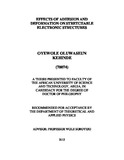| dc.contributor.author | Oyewole, Oluwaseun Kehinde | |
| dc.date.accessioned | 2016-08-05T14:59:24Z | |
| dc.date.available | 2016-08-05T14:59:24Z | |
| dc.date.issued | 2015-11-15 | |
| dc.identifier.uri | http://repository.aust.edu.ng/xmlui/handle/123456789/460 | |
| dc.identifier.uri | http://library.aust.edu.ng:8080/xmlui/handle/123456789/460 | |
| dc.description.abstract | This work presents the results of a combined experimental, computational and analytical study of the effects of adhesion and deformation on stretchable electronic structures. First, atomic force microscopy is used to measure adhesion in bi-material pairs that are relevant to organic,
inorganic and hybrid organic/inorganic solar cells and light emitting devices. The measured adhesion forces are then incorporated into existing models to calculate the interfacial energies.
The interfacial energies are then ranked in the electronic structures. Subsequently, the guidelines for lamination of low-cost organic electronic structures are developed. The effects of applied force on contacts between laminated layers are studied before estimating the crack driving forces
associated with interfacial cracks along the bi-materials interfaces. The conditions for successful lamination of the organic electronic structures are then predicted using experiments and models.
The failure mechanisms of inorganic stretchable electronic structures are studied. Wrinkled and buckled nano-scale gold films are formed on polymeric PDMS substrates before they are characterized using scanning electron microscopy. The interfacial crack growths between the films and substrates are studied using finite element simulations. The critical stresses needed for wrinkling and buckling are then analyzed using analytical models before explaining the potential implications of the results. Finally, the effects of stretching on deformation and failure mechanisms of stretchable organic solar cells are studied. Wrinkling and micro-buckling strategies are used to enhance the stretchability of thin films that are relevant to layers of organic
solar cells. Wrinkling and buckling of the films are simulated by pre-stretching prior to deposition and release of the films. The subsequent effects of wrinkling and micro-buckling are then studied using a combination of computational models and simulations of the tensile deformation of pre-wrinkled and pre-buckled organic solar cells. The predicted deformation characteristics are compared with the results of experiments presented in the literature. The predicted failure mechanisms are also compared with those obtained from experiments on stretchable substrates (with or without brittle indium tin oxide anodic layers). The observed failure mechanisms are used to explain the degradation of the optical transmittance and current-voltage (I-V) characteristics of stretchable organic solar cells. | en_US |
| dc.language.iso | en | en_US |
| dc.subject | Stretchable Electronic Structures | en_US |
| dc.subject | Oyewole Oluwaseun Kehinde | en_US |
| dc.subject | Prof Wole Soboyejo | en_US |
| dc.subject | 2015 Theoretical Physics PhD Theses | en_US |
| dc.title | Effects of Adhesion and Deformation on Stretchable Electronic Structures | en_US |
| dc.type | Thesis | en_US |

